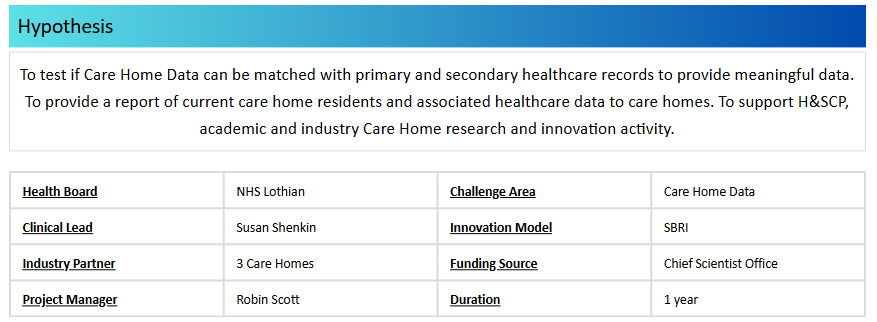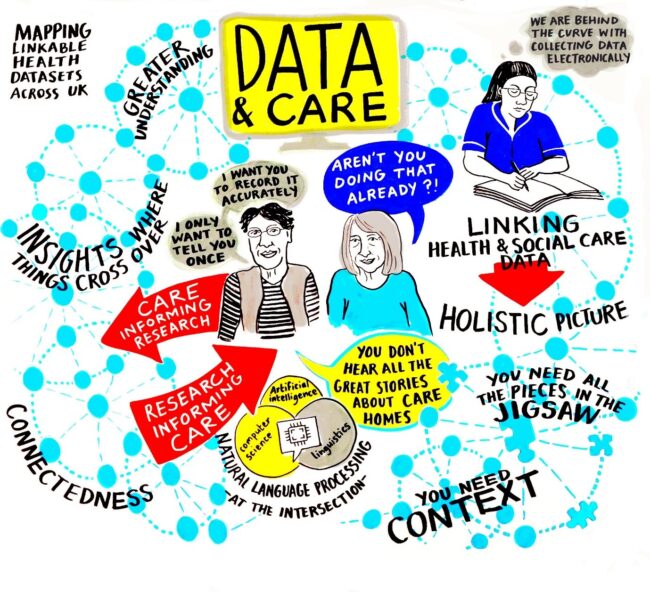Case Study – Care Home Data Sharing Partnership

Context
Scottish Government’s (SG) data strategy aspires to empower innovators, industry and researchers who can deliver new technology and data driven insights to improve and inform policy and practice. There is a need for significant work to make this a reality in social care, and particularly using individual-level care home data. We propose practical steps needed to strengthen the data foundations and ensure that the currently available care home data can be used, while working to maximise the future potential of this valuable asset.
Problem
Care Homes use several different systems to collect data on their residents to support their daily care and reporting to statutory bodies. These are not currently matched up with health or other social care records. Care homes may be privately owned, run by third sector, or the Local Authority, and therefore NHS processes for data sharing do not apply. Currently only very limited social care data are available in DataLoch, and no data relating to care homes. The inclusion of individual-level data from care home residents will be invaluable for future research and innovation projects to support planning and care of people currently in care homes, those moving into care, and transfers between the care home and healthcare (e.g. admissions to hospital).
Solution
We worked with three care home partners, and people in charge of ethics and governance processes in the University of Edinburgh and NHS Lothian, to build a method of safely and securely moving information about individual residents from the care home to DataLoch. We then linked this with information already held in DataLoch about GP attendances, hospital admissions and medicine prescriptions. We only included information about people who could provide consent for this (or who had someone who could do this on their behalf). We made a one-page ‘dashboard’ report about the information and shared this back with the care homes. This showed showing summaries of the health and care of the residents, and how well the information in the care home and DataLoch agreed with each other. We also used the Unique Property Reference Number (UPRN) in DataLoch to accurately identify four care homes, created a report of summary level information of all their residents’ health records, and shared this with care homes. We interviewed all participants to summarise lessons for the future.
Key Evaluation and Outputs Sought
1. Demonstrate feasibility of transfer of data from care home to DataLoch.
2. Link data from selected resident care home records with primary and secondary care data to produce
- a data quality report of linked data
- a report at care home level (aggregated summary)
3. Produce recommendations for next steps in linking data from care home residents and their primary and secondary health data based on understanding barriers and opportunities
Results
It was quite complicated to get all the agreements in place to safely and securely move the data, but we now have a process in place to do this. We were able to move information about residents from three care homes, link them to information in DataLoch and share this back with the care homes. They found these reports helpful, particularly as they could summarise changes over time. This was not possible for one care home, which only had temporary (respite) guests. We also were able to identify all four care homes (from three partner organisation) using the UPRN, and provide summary-level reports for all residents for each care home including only the information held in DataLoch itself (i.e. not using any information from the care home). The care homes found this very useful, particularly identifying changes over time, and gave us suggestions for improving these reports in the future.
The interviews told us that people involved in the project felt it was important to think carefully about how to balance innovation with the need for very strict formal processes; that care home data sharing could benefit both the residents and the care home systems; there were many barriers to the completion of the project, but also many things that that helped it to be successful. DataLoch are now writing a Care Home Data Pathway and discussing how individual-level care home data could be shared at scale without requiring individual consent for each project.
Challenges
- Addressing governances and legal concerns for novel project
- Care Home staff’s capacity to engage
- How do care homes get legal advice?
- Confidentiality concerns from residents/families
- Disconnect between health and social care data and governance processes
Learnings
- Start discussions with Information Governance on requirements at the beginning or before project starting
- The value of strong relationships, collaboration and good communication in innovation projects.
- Be clear of the process, reasons and end results to residents/families to build trust
- Need a good understanding of the care home context
Next Steps
This project has shown that there is a lot of enthusiasm for sharing data at both an individual-resident, and summary, level between social care and health – and many people believe this is already happening. It is important that care homes are supported to collect information electronically, and to get the financial and practical support they need to set up new systems and arrange to share data safely. It is feasible, and the processes are now established, but we now need to make this much easier to do at a larger scale, while making sure that this is done safely and securely. This is important both for research questions, and for the use of data in caring for people’s health and social care.

Graphic drawn by Claire and Jenny from MoreThanMinutes.co.uk from the Data and Care Session from the ACRC-AIM-CISC symposium 21st May 2025

Graphical summary of learning from qualitative evaluation of Data Sharing Patnership Project (interviews and analysis done by Dr Eddie Donaghy and ACRC PhD student Nicola Crowe), drawn by Clare Mills of www.ListenThinkDraw
